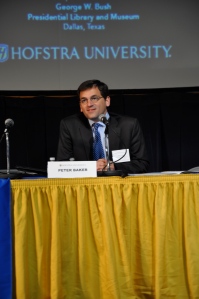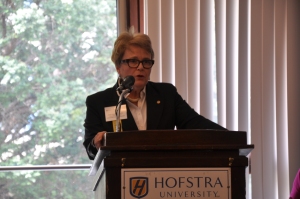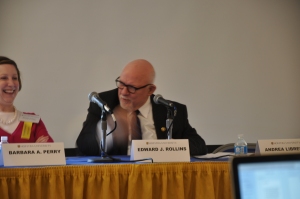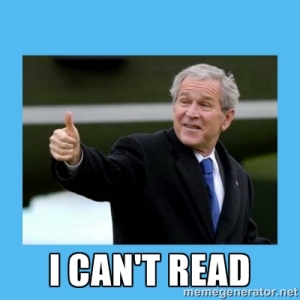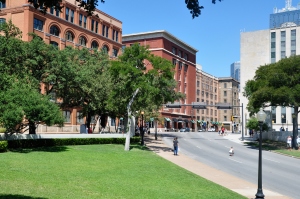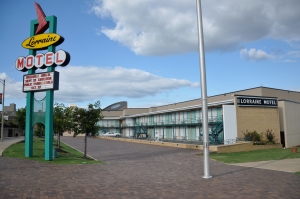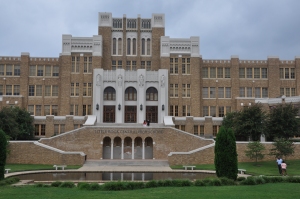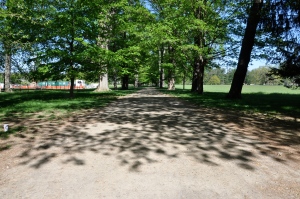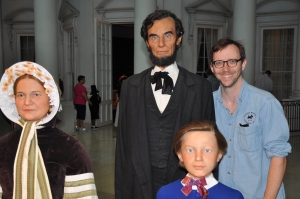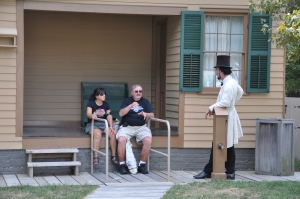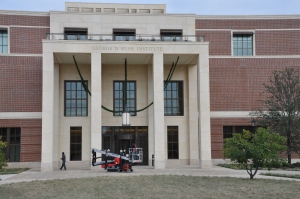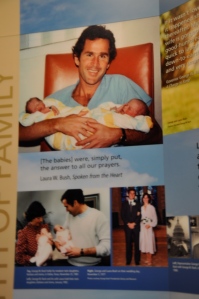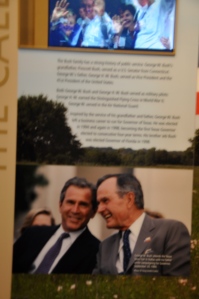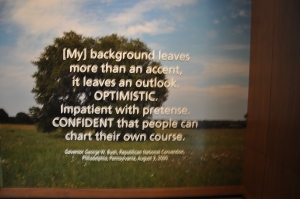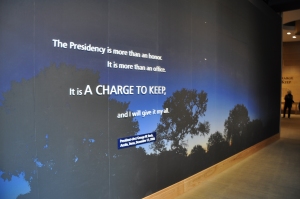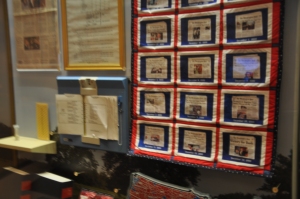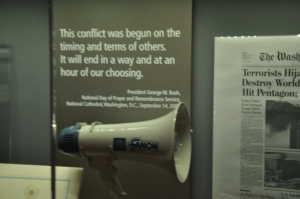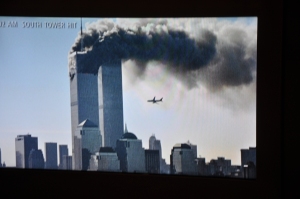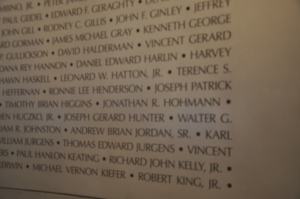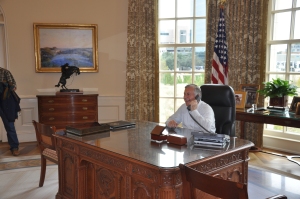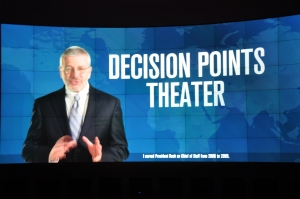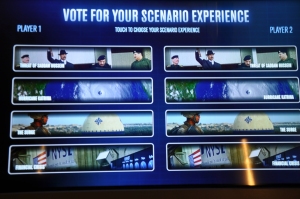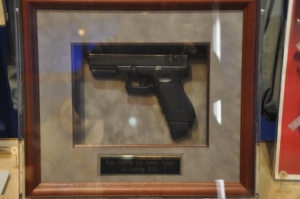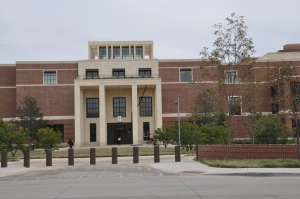I am reminded of December of 1999 when everyone believed that the world was going to end at 12:01. If you were around, you remember – computers were going to stop, lights were going off, perhaps bombs were going to start flying. It was all over. Then, at 12:01, we noticed that the lights were still on, and that a lot of us had wasted a lot of time worrying about this nonsense.
This year is the opposite. Everyone has started talking about 2020 as if it were a belligerent animal, assuming that all will be magically better at 12:01 tonight.
Tomorrow is a beginning, but every day is a beginning. Let’s make the most of it.
Unlike every Hofstra Conference in memory, the big news here is not who appeared, but who has not. Every ex-President since Jimmy Carter has appeared at the conference. Every major person in this Administration, though, from Dick Cheney through Barney the dog, has chosen not to attend.
After day one of conferences, it is easy to see why they all chose to stay away. Phyllis Bennis, in the final discussion of the night, voiced her opinion that it was a good thing that Bush chose not to come. “This is not a proper place for him,” she added. “The only place proper for him and many in his administration is at the Hague, being tried for war crimes.” In other words, while Mark Updegrove may well have been able to convince attendees at last year’s LBJ Civil Rights forum to move on from Vietnam, few in this audience are ready to grant the same thing when it comes to Bush and Iraq and Afghanistan.
For the most part, the only Bush Administration folks who showed up are unknowns who arrived in the second term, after the bulk of the decisions had already been made, people who tentatively defend their president under the vague rubrics of patriotism and safety. Many times we have heard that hindsight is twenty-twenty.
Starting the conference was Peter Baker, the author who wrote the riveting and authoritative book, Days of Fire: Bush and Cheney in the White House. “I find the Bush Presidencey to be endlessly fascinating,” he said. “Iraq, Iran, Pepfar, No Child. He had terrorism, national disaster, economic disaster…They were all days of fire.”
Baker went on to differentiate, as he does in his book, Bush’s second term from his first. Unfortunately for Bush, it is those decisions he made when still seemingly in his fateful bromance with Dick Cheney that continue to mark his administration in most people’s eyes.
Few were willing to cut him much slack when it came to No Child Left Behind either. Alan Singer, a professor at Hofstra who arrived wearing a t-shirt showing Bush reading a book upside down, ended his talk with a rap that presented his position that many children were left behind. It was left to Anne-Imelda Radice, to discuss the difficulties of governance. “It was an imperfect law, but we should be talking about how to embolden it,” she said, adding that Bush should be congratulated for having the guts to putting the issue in the forefront of his administration and for talking about the racist implications of low expectations. When a young participant asked Singer what he would do instead of the Bush plan, Singer stated that he believed that all children should have the same opportuniteis that Obama’s children have. Which really was not an answer.
Edward Rollins, once the firebrand behind Reagan’s election, is now an elder statesman, and discussed how “complicated” it all was.
So true. It is this mixing of journalists, academics, and politicians that make these conferences so interesting.
More to come.
As I set out upon the road from Philadelphia toward Hofstra University to attend their George W. Bush Symposium, my mind wanders along familiar corridors. Having visited W’s Presidential Library recently, I listened to the familiar refrain of tired jokes – that there would be no books in the library or that several of them had not yet been colored in yet. (In fact, Bush is a voracious reader of history.) Any tentative response that W may not have been a lethal combination of Genghis Khan and Daffy Duck brings confused reactions, as if I am presenting a possibility heretofore unthought of. One acquaintance of mine who I had recently engaged over a vehement argument during which I defended Edwin Snowden told my wife that he suspected I must be truly conservative since I did not use my visit to the W Library as an excuse to pour ridicule on the 43rd President. Those who complain about Republicans who do nothing but condemn President Obama fail to look into the mirror and consider their possible psychic connection to them. And, oh, how they would have howled if Bush, and not Obama, was discussing military involvement in Iraq. How they would have howled over the disclosures of governmental eyes looking over our personal emails and and governmental ears listening to reporters phone calls. And the cries of “Impeachment” that would have followed any disclosures of the IRS setting out against political enemies.
When Bill Cosby – this was before all of the disclosures about him came out – was asked about criticisms of Obama, he had responded, “I don’t think anybody considers how difficult the job of being President is.” Which caused me to wonder who the heck was considering how hard the job was back when George W. Bush was responding to the nation’s greatest foreign policy crisis since World War II?
The whole point of my trip to visit the presidential libraries (Chasing the Presidents: One Man’s Road Trip Through the Presidential Libraries, available at Amazon) was to try to get a more balanced view of these people, one less infected by my own prejudices as well as those around me. And so I decided to try to look at even George W. Bush with fresh, an not prejudiced, eyes. I look forward to hearing what people have to say at Hofstra.
For a some time now, the kickoff for presidential reassessment has been marked by Hofstra. I recall driving through California in 1987 and, at the hotel, flipping through C-Span to find the Hofstra Conference on Nixon. My wife and I sat glassy eyed for two days, watching as Haldeman, Ehrlichman, Chuck Colson, Brent Scowcroft, Tom Wicker, and Henry Kissinger spoke about the enigmatic president and his Administration. Back then I hoped that one day I would attend such a conference, and now the day has come.
Tomorrow, that day will come.
I will keep you posted.
In my recent Op-Ed piece in the Post, I wrote about several of the reasons I am an enthusiastic advocate of Presidential Libraries, but I held back on one of the most important reasons because I knew it would not seem professional. It seems to be a necessary attribute of professionals in the history field that they be careful, meticulous, thoughtful, and – most importantly – never excitable. How then can I bring up that most important factor, the goose bump factor – the feeling you get when you come face-to-face with history in a way that makes you want to jump up and down?
But in truth, that’s what I’m after. It’s what made us interested in this stuff in the first place, isn’t it? And sticking papers in one place is going to seriously minimize those goose bumps. (Although it certainly won’t take them away all together.)
Goose bump moments often come out of you by surprise, but not always. The first time I came upon Dealey Plaza in Dallas, it was goose bump city. Staring down from the book repository at a scene that was at once so familiar, and yet so strange. Familiar because I, like anybody my age, had stared at hundreds of pictures of the scene, had scene the Zapruder film, had looked at the map. And yet, it had always seemed so much larger in my mind. That part of Dallas reminded me less of, well, DALLAS and more of Roanoke, Virginia. And there, right down there on the street, was where our history was changed. Goose bumps.
A few years later I came across the Lorraine Motel and experienced the same springy mixture of excitement at being at visiting such a familiar sight, and nausea at what made the place so familiar.
Driving with my daughter across country, I saw a sign advertising Hope, Arkansas. How could I drive past a place called Hope? I couldn’t. I pulled over, it was a weekend, everything was closed, the town was deader than it usually was. And there it was, that small white house. Only in America I thought, perhaps tritely and incorrectly, but standing there I felt as far away from the world of glitz and power that Clinton now inhabits than I have ever felt. Looking at the train track, I recalled that Clinton had called the train sound the loneliest sound in the world. I imagined him as a young child, hearing those trains, knowing that one day he would be on one of them, knowing that one day he would move on from Hope, Arkansas, to bigger, though not necessarily better, places.
I was only a little bit down the road in Little Rock a few years later when I came across City High School, the school that was the center point of the Little Rock desegregation crisis. There was that large, almost stoic building, looking exactly as it had looked before, and I imagined those crowds, imagined young Elizabeth Eckford and those who had taunted her. It was like being on a historical battlefield with the ghosts still crying out. Hard to imagine that to the kids who went thought those doors, it was just school, but, fortunately, that’s exactly how it is.
At the Roosevelt Library I had a few goose bump moments, but the one that really stuck to me was standing on that long, long driveway that Roosevelt used to try to walk across with his crutches, never making it, but always trying. I have read numerous books about Roosevelt’s disease and his extraordinary tenacity, but nothing has impressed me as much as that driveway.
I recall sitting across the street from Abraham Lincoln’s house, reading a book by his old friend and associate Herndon, and hearing a train whistle, and being struck by the fact that it was the same train line that took Lincoln away from the town of Springfield and to Washington, and that brought his body back after it was all over.
History is so much more than facts and documents, and the best writers – the David Halberstams, the Robert Caros, the Doris Goodwins, the Taylor Branchs – know how important it is to unlock the imagination, to try to feel the feelings of history, and then to put them on the page. Robert Caro has said that writing about an exciting historical event in a way that is not exciting is not only bad writing, it is bad history. And these libraries, by bringing us face to face with so many potential goose bumps, are actually bringing us face to face with history. We have to open our minds, open our eyes, but also our hearts. We have to be children again, with the excitement that we once felt on Christmas morning, opening a present, not knowing what was in there but knowing, whatever it is, it will be good. We have to feel goose bumps.
Today the Washington Post published my Op-Ed responding to Jonathan Zimmerman’s criticisms of the Presidential Libraries.
He spoke in the clipped tones of a military man, each syllable enunciated so that any dunce could – and would – do as he said. “No photographs outside the museum!” He was standing next to the metal detector at the George W. Bush museum, and his tone indicated that this was no small matter, that terrorists might want very much to see the George W. Bush metal detector.
Bush’s second Secretary of State, Condaleezza Rice, was fond of saying that every day after September 11th had been September 12th for her and the Bush Administration. So here I was, on Septemeber 12th – not really, it was a freezing cold day on November 14 – being reprimanded for taking a picture of a metal detector. But I couldn’t help myself – I had visited all of the Presidential Libraries, but none of the other ones had required a metal detector. Maybe the terrorists have less of an interest in the others. Would Barack Obama’s Library have a metal detector, I wondered. Probably. Later, I would see a guard standing at the entrance of the national archives, protecting those papers and emails that were within. Personally, I think if any terrorist were to go after archives, he would be more likely to go for the unprotected ones of a George W at Mount Vernon, rather than these ones, but perhaps you can’t be too safe. (That might be the motto of the Bush years, come to think of it.)
It had been a long journey for me to get inside this library. When I took my cross-country trip to visit all of the Presidential Libraries, this was nothing but a large hole in the ground. Still, I dropped by the site, to see a Presidential Library at its inception, I suppose, and visited with its Director, Allan Lowe. When I later contacted Mr. Lowe about getting a press pass for the Library’s opening, I was surprised and delighted to receive an e-mail granting my request, and giving me access to the press walk through of the Library, and to the ceremony, which would include each of the ex-presidents, as well as President Obama. I was still putting the finishing touches to my book and thought that perhaps this would make for a perfect ending.
When I arrived at the Library to pick up my credentials, I sensed immediately that something was wrong. I was dealing with a college student, I assumed, and she couldn’t find my name on the list. When I showed her the email, she had some whispered conversations before she returned with a giant smile that was meant to convince me that I was not being thoroughly screwed. Yes, I would be allowed into the absolutely best place to see the ceremony – the basement! Unfortunately, I could not go to the press viewing of the Library. And, no, there was no possibility of me actually getting to go inside the Library.
So there you had it. I could watch the thing in a basement on a giant television screen. I noted that I could have watched the thing at home on C-Span, I didn’t really need to be there to do that, but she was unmoved by my sentiment, still trying to sell me on the idea that I was very lucky indeed to secure such a prime spot.
It was interesting, at any rate, to see all of the little trucks, and the soldiers jumping out of them and performing paramilitary exercises. Everybody, it seemed, would be at this ceremony. Not only the President and all of the ex-presidents, but numerous national and international luminaries. There was a charge in the air and people were a little nervous. This was, after all, Dallas.
I had my revenge, of sorts, by talking one of the guards who were everywhere that morning into allowing me into the field where the ceremony was taking place. Seated between a Fox person and a New York Times person, I was astonished when that same frigging girl spotted me out of the thousands of people who were present, and told me that I was not permitted to be there and I would have to come back with her to the basement. “You’ve got to be kidding,” I told her, but, in fact, she was quite serious. So was I. I told her they would have to arrest me in front of the news folks if they wanted to get me out of there. She stalked off and I saw her talking to a couple suits, with their ID’s swinging on a chain around their necks, but, alas, I was permitted to attend the event unmolested.
So it was with a bitter taste in my mouth that I left Dallas. It would have been fine had they not given me a press pass, but to promise me one, causing me to spend the money for the flight and the hotel room, and then take it back was a bit obnoxious. I gave only a cursory recounting of the story in my book, not wanting to blame the Library for some overzealous underling. (And yet, this would NEVER have happened at the Roosevelt Library. Had some kind of mix-up like this happened, I have no doubt that I could have contacted one of numerous people there and they would have seen to it that I was at least permitted access to the exhibits.)
Still, I wanted to see the place. My book was published and I was being interviewed as an “expert” on presidential libraries – if you write a book, it doesn’t matter what amount of knowledge you have, you become an “expert” – and yet I had not seen the newest member. I knew that, at some point, I would need to change that. When a friend invited me to go to Dallas with him on an unrelated matter, I thought – perfect! I purchased the plane ticket but then, to my chagrin, the government, including the Presidential Libraries, closed down, due to the incessant squabbling between its branches. The plane ticket, I discovered, was nonrefundable – more money wasted on a trip that was taking on Homeric dimensions. Would I never get myself into the Bush Library?

Well, finally, here I was, at its precipice. I put my camera away and did as I was told by the guard – I really didn’t want any trouble. I got through the metal detector and then – voila – I was in the Library! I had made it!
I knew that the Bush Library was the second largest, and based on talks I’d had with Lowe as well as what I’d heard from media accounts, I expected good things. The first thing I noticed was that there is very little pre-presidential material. I had hoped for some discussion of his Prince Hal years of drinking and debauchery – it is one of the things I like about his memoir that he is upfront about that period of his life, and goes into his drinking and his decision to stop with some depth. His decision to quit drinking was, to his way of thinking, one of the key “decisions” that made him president.
We get a few comments about his faith, his values as derived from his Texas upbringing, and, of course, his family. There is a slight commentary referring to his governorship, and then it is on to the election. We all remember, of course, the battle over Florida and the dimpled ballots (of which the Library provides a sample to show how so many Jews in Florida ended up mistakenly voting for that anti-semite Pat Buchanan!) The film describing the thirty-six day battle reflects the Bush point of view about it, but is not overly partisan. After that, I was ushered into the theater to see the film.
“I don’t think anybody can be fully prepared for the moment when you’re getting a briefing on a national security issue, and everybody turns to the president and says, ‘What are we going to do Mr. President?’” Bush says at the start of the film. “Until that moment happens, it’s hard to understand the enormity of the presidency.” From there we go to 9-11 but, surprisingly, the movie doesn’t dwell on it too much. After showing him “throwing a strike” at the World Series game in New York, it moves on to his Texas background (where, Laura says, “people are hardworking and solid and there is no pretension”); No Child Left Behind; Pepfar (his emergency plan for Aids Relief in Africa). “I never wanted to be a wartime president,” he says. Iraq? Not specifically mentioned, although he does state that he believes that all people want to be free, and that America has a duty to do what it can to bring that freedom to all the world.
Any president uses his library, at least partly, to put forward his view of events with the hope that it will effect what becomes our history. The very beginning quote of this movie gives us the point of view that Bush has been pushing both during and after his presidency, that of his being “the decider.” A president, unlike almost anybody else in the country, does not have the luxury of simply gassing about an issue or a problem. When things come to him, they come to him for one reason and one reason alone – a decision must be made. The title of his book, “Decision Points,” makes this clear. A presidency – a life really – is a series of decisions. And nobody can judge the decisions that are made until he or she looks at them from the decider’s point of view, looks at the various arguments and potential results. Only then do we begin the process of judging another’s actions.
During my visits to bookstores and libraries to promote my book, I am often asked which presidents did I gain respect for after visiting their library. The truth is, almost all of them. Inevitably, if I look at any of the issues a president had to decide carefully and dispassionately from the president’s point of view, I usually have a much more sympathetic view of what they did. (Although there are exceptions.) It has become too easy in our society to sport opinions without thought or any basis of knowledge. I am coming to believe that it is one of the great problems we have, something we all engage in to some extent or other. By discussing the issues the way Bush does, he tries to force people to take a deeper look at the choices he made. The point is not that we will come to agree with all of them, but to at least move us past the cartoon characterizations of things that take up so much space in our culture.
Once the movie is over the patron walks into a section on “No Child Left Behind.” I know very few parents who feel that this law has been a success. It has in many instances caused greater problems, including far too much emphasis on standardized tests. However, I think most parents appreciate Bush’s concern about education and the fact that he was trying to make things better. It is astonishing that Democrats are not decrying the vast separation between the good schools and the bad ones, and that it has been left to the likes of Condoleezza Rice to say what should be obvious, that the disparity of the schools is the greatest civil rights issue of our age.
September 11th is, of course, part of this museum. There is a wall with the names of the people who died on that day as a result of the terrorist attacks, as well as some movies. And that megaphone, the symbol of one of Bush’s great moments, when he spoke off the cuff to the workers in New York. “I can’t hear you,” one of them yelled. “I can hear you,” Bush responded. “The rest of the world can hear you. And the people who knocked these buildings down will hear all of us soon.” Judged as rhetoric, the linguistics are perhaps banal, but nobody can deny the power of them at that moment. The fact is, for all of those who made fun of Bush’s speaking skills, nobody could have made a better statement than that one, or made it in a better way.
Of course, the Bush Library has a lot of splainin to do. The battles of Afghanistan will falter and peter out and become one of many casualties of the Iraq War. And there is, of course, that little matter of weapons of mass destruction not being found.
A president’s first exhibit is generally given a lot of latitude. We understand that it is not meant to last forever, and it has the president’s imprint on it to such an extent that it sometimes can be a little tedious. There are also presidential libraries that have been around for some time and still refuse to acknowledge and address alternative views. But the Bush Library does a good job of addressing the issues that confronted him. You might not like the spin they give to the Iraq War, the Patriot Act, Guantanamo Bay, or the torture used against suspected terrorists, but you should at least credit them for addressing them, rather than simply ignoring them.
As to the Iraq War. Again, we get back to decisions. The decision, Bush says, came to this – the guy was refusing to allow the U.N. weapon inspectors to do their job. He had used weapons of mass destruction in the past and had slaughtered his own people. He had defied seventeen U.S. Resolutions. Reports (later proven to be incorrect) stated that he was building weapons of mass destruction. He harbored terrorists. “Before 9-11, Saddam Hussein was a problem America might have been able to manage,” Bush tells us, “But after 9-11, the stakes were too high to trust a dictator’s word against the weight of evidence and the consensus of the world.”
Ok. Decisions. But… We don’t always make decisions for the reasons we say we do, or even for the reasons we think we do. This decision, as it is described throughout the museum, is robbed of its context. Left out of the discussion are some pretty relevant factors, such as –
1. Many within the Bush Administration (Wolfowitz, et al) felt that the father’s war against Saddam had been ended prematurely, and they began the Administration aching to “finish the job.”
2. The duo of Rumsfeld/Cheney were heavily in favor of this war and pushed Bush to conduct it.
3. “Evidence” such as the phony intelligence from Britain that was pushed by the Administration was used to shore up the Administration’s reasons for the war.
4. Hussein attempted to murder Bush’s father!
The library is solely interested in Bush and Bush’s decisions. However, there
have been few administrations in which the makeup of the underlings was more important and more intriguing. Cheney merits barely a mention in this place, but for many, he was the true president of the United States during the Bush Administration. This is an unformed and inaccurate belief, but there is no doubt that his vice-presidency was a unique one and that he was probably the most powerful vice-president in American history. There is no mention of this unique partnership, however. Nor are there discussions of the battles between Colin Powell and Cheney or between Condoleezza Rice and Rumsfeld. There was a battle for the soul of Bush throughout the Administration – was he the tough-thinking no-holds barred conservative that Cheney wanted him to be, or the compassionate internationalist that Rice saw? Bush’s two terms can be seen as two Administrations – in the first, he sought the council of Cheney and usually followed it, but, in the second, Cheney’s power was seriously diminished as Bush sought to retreat in many of the areas in which he had followed Cheney’s advice earlier but been universally condemned.
The museum provides a movie that seeks to address most of the tough issues of the Bush years, and it is Condoleezza Rice who does most of the talking. The answers she provides to complex issues are simple. The Patriot Act. (“We needed to make use of every tool in our arsenal.”) Civil liberties? (“On a daily basis President Bush made really, really tough decisions, decisions that can only be described as matters of life or death. Only when he was satisfied that we could protect both our liberties and our security did he signal that we could go ahead.”) Iraq. (“[Saddam Hussein] was a sworn enemy of the United States…When we invaded Iraq to enforce the will of the international community, we did so because Saddam Hussein was a security threat.”) It is left to Bush to admit that “we were wrong” when it came to the security belief that Hussein had weapons of mass destruction. As to the waterborarding program, the President asked two questions, Condoleezza tells us – he asked the CIA if it was necessary, and the Justice Department if it was legal. We then hear a clip of Bush telling us about the “vital information” derived from the process.
As I say, they deserve credit for at least discussing the issues. No serious student of this period though could claim that this discussion is in depth, or that it does not leave out major points of contention. (The weapons of mass destruction is mentioned as one of many reasons for invading, when, at the time, it was used as the major one. He certainly knew that there was a divergence of opinions as to the legality of the waterboarding, as well as to issues of the Patriot Act.) Condaleezza leaves us with her final conclusion, what they clearly consider to be the unanswerable final point: “The fact that we had no further attacks can be attributed to the difficult decisions in a time of war after September 11.”
Many of these issues seem less controversial now then they did at the time, because President Obama, despite having had deep criticisms, signed on to many of them and even advanced some. Issues regarding the Patriot Act and privacy are almost unheard of now, as Obama has served, in many ways, as the Eisenhower to Bush’s Truman – he has set into concrete those intelligence programs that were once merely the programs of one president. In the end, Bush may owe thanks to Obama, who has helped more than any other person at his eventual rehabilitation in the history books. What is most notable about President Obama’s recent decision to send advisors into Iraq is how little controversy it stirred. No longer is there the need to argue about weapons of mass destruction. In the post Bush world, it is granted that we have an interest in Iraq and the Middle East, and President Obama has been spared the gut-wrenching exercise that Bush had to go through. But, really, if it made no sense to go into Iraq then, why does it make sense now?
Visiting a presidential library is a first step, not a final step, toward understanding a president. For those who want to delve into these issues, there are books aplenty on the subject and, no doubt, many more to come.
I was looking forward to the Oval Office, which is advertised as the only full one offered by the libraries that you can actually walk about and sit in, but I was disappointed. It felt more like a hotel room then the Oval Office, frankly, and they cheaped out on a desk that was not the proper size.
My favorite part of the experience came at the Decision Points Theater. People sit in this large theater and experience a decision that Bush had, right along with various pieces of advice from experts and interruptions from news flashes of events. After two Bush advisors (Josh Holton and Andy Carr) introduce themselves and explain the exercise, the people in the auditorium get to vote on what issue to confront – The initial decision to go into Iraq, the decision on the surge, the decisions on how to respond to Karina, and the decisions on Wall Street and the financial crisis.
The vote came up and we were going to decide about Iraq and Saddam.
Voices explain the problem, which is that weapons reports show that Hussein is not following U.N. resolutions, that he is obtaining weapons and refusing to allow inspectors in. The weapons inspectors want to know, specifically, whether there are weapons of mass destruction. Hussein is defiant.
“President Bush had to make a choice!” the narrator says. “One, seek a new U.N. resolution, two, lead an international coalition to remove Saddam, three, take no action and accept that Saddam Hussein will remain in power.”
Now come the voices of the advisors from the White House and military, as well as congressmen and senators, all giving conflicting advice. You can scroll a touch screen to choose the advice, and then show how much you agree or disagree with the advice given by scrolling your opinion. “Intelligence indicates that Saddam has weapons of mass destruction, and don’t forget, during the Gulf War we found that Saddam was much further along in developing nuclear weapons than anyone had believed,” says one White House aid. “There is no sign that Saddam Hussein is preparing an attack on the U.S.,” says another. “If we act to depose him, other countries can use our actions to wage unjustified wars in the future.” On and on come the advisors, telling him to get a new resolution, urging caution, urging war. As the advice comes in and the large clock ticks, there are various interruptions from world events. “Time’s Up!” announces the narrator. “It’s time to make a decision.” The consensus of the audience is to lead the coalition into Iraq. Next comes Bush to tell us what he did and why: “My first choice was diplomacy…The U.N. had already passed sixteen resolutions demanding Saddam Hussein disarm. I was hopeful that the seventeenth security resolution threatening serious consequences if he did not comply would get his attention…Rather than accepting Saddam’s defiance, we led an international coalition to topple his regime…Saddam posed too big a risk to ignore…The world was made safer by his removal. With his departure, twenty-five million Iraqis were allowed to live in freedom. We view the democracy in Iraq as a valuable ally in the Middle East, and a beacon of hope to reformers around the world.”
I liked the exercise, but the main point seemed to be missing. It wasn’t as if anybody felt that the absence of Saddam Hussein would be a bad thing. Nobody felt that. The question was, was it worth lives of Americans? Within the museum we are made to feel the tragedy of the deaths on September 11th, but not those that occurred after as a result of this war. In 2006 the count had come to 3,000 American lives, and 35,000 Iraqi lives. That’s what this decision was about, and it’s a subject missing from the museum debate.
Before I finished off, I took a look at the pistol Saddam had when he was captured. Neat, although I really wish that somebody had had the presence of mind to take the shoe that had been thrown at him during that press conference in Iraq.
I left the museum and had a delicious lunch at “Café 43.” Over my potato galette (“local greens, fall vegetables, red pepper ragout” and very very good) I pondered the visit. If you conducted a national survey today, I am sure that Bush would have a much higher approval rating than he did during his last years. That is inevitable. But the question is, why so much hatred of Bush? Why do so many of my friends despise him but, when confronted with the fact that Obama has continued many of the same policies, come up with excuses for the current president?
Why the hatred? Why is it that, whoever the president is, half the country feels that it is necessary to despise the guy? This I don’t know. But it is one of the reasons I took my trip to get to know the presidents better. I wanted to rise above my own unformed and unfair opinions regarding many of the presidents. Had he not been diverted by Iraq, just how would he be remembered? My feeling is that those on the left would have despised him anyway, and those on the right would have resented his moderate leanings. (There is a section at the Library on Immigration Reform, something he fought for and something Republicans continue to shoot down in any form today.) It’s a tough job, no doubt about it, but it shouldn’t be an impossible one.
The Library does a good job and advances the chances for serious and constructive debate on the subjects of the Bush years. Check it out if you can. And, even if you still hate Bush, there is no way you will hate this potato galette.
Speaking to recalcitrant Republican congressmen who did not want to support President Bush’s plan to stave off economic disaster in 2008, Vice-President Cheney warned, “If you don’t pass this, you’re going to make George W. Bush into the Herbert Hoover of the twenty-first century.” It is telling that, even for a conservative such as Cheney, there could be no fate worse than that of being remembered as Hoover, the president who – we are taught – stood by uncaringly as the stock market crash caused the Great Depression.
Winston Churchill once said that he knew history would be kind to him because he intended to write it. Hoover probably knew that history would never be very kind to him, but he still did his best to combat the view of him as the president who caused the Great Depression and then stood idly by as it ravaged his country with his multi-volume memoir, three volumes of which were published during his lifetime.
While Hoover may not have hoped for kindness when it came to the history books, he was at the very least going to put out his side of events. His three volume memoirs – later posthumously added to – advanced his perspective of the Great Depression, as well as other issues of his presidency.
It is the first volume – Years of Adventure – that I found to be most illuminating, as well as entertaining. Say that you’ve been entertained by a book by Herbert Hoover, people might start wondering if you have gone off the deep end, but that is simply because few people have read this disarming and sometimes riotously funny book.
Hoover’s childhood can only be described as Dickensian. Orphaned at nine, he ended up living with an Uncle who required him to work the farm in return for his food and shelter. Still, Hoover goes out of his way to describe his childhood in idyllic terms and chooses not to delve into subjects that might prove depressing. (The fact that he lost both his father and a mother as a young child is buried in a footnote, written in the third person.) “I prefer to think of Iowa as I saw it through the eyes of a ten-year-old boy,” he begins his book. “Those were eyes filled with the wonders of Iowa’s streams and woods, of the mystery of growing crops. They saw days filled with adventure and great undertakings, with participation in good and comforting things. They saw days of stern but kindly discipline.”
The “good and kindly discipline” was actually harsh and unremitting, and caused Hoover to live with one overarching goal, which was to make enough money that he would never need the help of anybody else. He missed out on early school but talked himself into the very first class of Stanford.
“On leaving college, I needed at once to find some person with a profit motive who needed me to help him earn a profit.” He got a job as an engineer in Australia, and performed well enough that he eventually received a much higher salary engineering in China. As soon as he received the job offer he sent a cable to a woman he had fallen in love with at Stanford, Lou Henry, asking her to marry him and move to China immediately. “She thought that was possible,” he writes.
What awaited the two of them in China was “the boxer rebellion,” which was an armed uprising to purge foreigners from the land. The danger was severe. “An increasing number of foreigners – soldiers and civilians – were wounded,” he notes. “Mrs. Hoover volunteered at once and I saw little of her during the first period of the siege, except when she came home occasionally to eat or catch a little sleep. She became expert in riding her bicycle close to the walls of buildings to avoid stray bullets and shells although one day she had a tire punctured by a bullet.” On another occasion, he recalls his wife playing solitaire when a shell “banged through a back window and then, exploding, blew out the front door and surroundings.” His wife, “never stopped the game.”
There were other adventures as well. Learning that an American Captain was putting innocent Chinese civilians through a sham trial with the intent of executing them, Hoover raced over the Russian headquarters on a bicycle, and convinced a Russian platoon to return with him to save the Chinese civilians. “The siege lasted about a month,” Hoover writes. “We did have one dreadful person who periodically wanted to know if I intended to shoot my wife first if they closed in on us.”
This first volume has much of these kinds of stories, combining adventure, romance, and humor. Hoover’s pre-presidential life was certainly one of the most interesting in our history. He goes on to describe, in deadpan terms, the manner in which he saved the lives of hundreds of thousands of Belgiums and Russians who threatened to expire from lack of food.
He dedicates his second volume to the Great Depression, starting with the assertion that “The Depression Was Not Started In The United States.” It is one of the ironies of history that current economists agree with Hoover. But this seems to matter little next to teachers and historians who continue to follow the timeline of events with little curiosity about causation.
The final two volumes read like an attorney’s arguments to history, and there is less of the humor and simple joy of the first volume. (Although it returns now and again, such as when he spends a chapter on his beloved hobby, fly-fishing.)
The Hoover memoirs, when compared to those of other presidents, are well written and interesting. And, who knows, the day may come when historians will take a look at them and give Hoover’s claims their due.
In my book, “Chasing History,” I wrote about my cross-country trip visiting all thirteen of the official Presidential Libraries, which include each presidency from Herbert Hoover through George W. Bush. It is my contention that the brilliance of Franklin Roosevelt’s idea of the Presidential Library is that it combines the papers of a president with physical landscape that was important to him. The researcher interested in Herbert Hoover will see not only the cut-and-pasted speeches that Hoover struggled over but he will also see the tiny house he grew up in, and the Quaker church where he worshipped. Looking at Roosevelt’s Hudson river, Reagan’s mountainous Simi-Valley, Lyndon Johnson’s ranch, and the house Richard Nixon’s father built with his own hands can only bring the researcher closer to the person he is studying.
When I argue with my academic friends over the value of the presidential libraries, I say that the library, in most cases, is the first step, not the last, when it comes to understanding a president. The hope is that a patron who visits one of these institutes and becomes interested in its subject will go out and learn more about him by reading various books and watching documentaries or video clips. In “the argument without end” that is presidential scholarship, you will find books written by the presidents themselves, cabinet members, critics, reporters, political scientists, and historians. Some of these books have minimal impact while others seem to define a president for generations.
During the next several weeks, I am going to look at the presidencies (and personalities) of Herbert Hoover through Barack Obama, not by discussing their libraries or hometowns, but by discussing the books (and in some cases DVDs) that are out there and that help us understand the presidents. I am also going to look at those books that have had the greatest impact on our view of a president, fairly or unfairly.
And so, as to begin our journey, we travel to West Branch, Iowa, and view the streams and woods and the mystery of growing crops through the eyes of a ten year old boy.
#10 – Kennedy, Starring Martin Sheen

Based on Sorensen’s book of the same name. Sheen – yes, he was Kennedy before he was Jeb Barlett – does a good job as does the supporting cast, particularly Blair Brown as Jacqueline. E.G. Marshall does a good job as Joseph Kennedy, and Vincent Gardenia is a good Hoover. Surprisingly, the movie portrays the assassination in somewhat gory detail. The movie, while a tribute, does not go too far into idolatry, and even makes a few pointed references to Kennedy’s womanizing. The biggest drawback are the numerous scenes of JFK’s parents watching events on television and then commenting on them, a tired device that becomes more burdensome with each use.
#9 – The Reagans, Starring James Brolin

After all of the controversy that accompanied this movie, I didn’t find it to be quite the attack that Reagan partisans saw. James Brolin does a capable job as the somewhat vague and mystifying Ronald Reagan.
#8 – Warm Springs, Starring Kenneth Branagh
This is the movie that portrays FDR as he convalesces in Warm Springs Georgia, trying to regain function of his legs. The somewhat overstated thesis is that it was his time with other victims such as himself that rose him from being a rich, petty, and unremarkable politician to the Roosevelt we know. Branagh never reminds you of Roosevelt much, but this is not a crushing defect. Other Roosvelt dramas include Eleanor and Roosevelt, which starred Edward Hermann and Jane Alexander, which now seems a little dated and tiresome, and Hyde Park on Hudson, which, despite a nice job by Bill Murray, is a terrible movie based on irrelevant and pointless speculations.
#7 – The Adams Chronicles
This was a PBS production that included the presidencies of both John and John Quincy Adams. John Adams was played by George Grizzard, who did a very good job but was perhaps outdone by Kathryne Walker’s Abigail. Perhaps my favorite part comes when William Daniels, who will long be remembered for his classic performance as John Adams in the musical 1776, plays the elderly John Quincy Adams. More recently, HBO won plaudits with its adaptation of David McCullough’s John Adams, but I found Paul Giamatti’s performance to be off base.
#6 – The Final Days, starring Lane Smith
Smith is not great as Nixon, but he is good enough to make this production, which follows along the lines of the Woodward/Bernstein book of the same name, successful. There is also the hilariously burlesque Oliver Stone movie, Nixon. This is a movie that is truly bad enough to be good. There is Hoover making Clyde Tolson jealous over the waiter; Nixon becoming unglued because a hippy girl figured it all out and knew that even Nixon was powerless against the nameless conspiracy that runs the country; and Larry Hagman showing up to play a Texas Oilman exactly as he played J.R. Ewing. Have a margarita, sit back and have some laughs with this one. If you are a real glutton for punishment, follow it up with Stone’s equally ludicrous “W.” More recently there was Frank Langella’s performance in the sub-par Frost/Nixon.
#5 – Truman, starring Gary Sinise
Sinise does a good job on this mini-series which effectively portrays the Truman years.
#4 – World War II – When Lions Roared
At first this miniseries, which portrays the relationship between Franklin Roosevelt, Winston Churchill, and Joseph Stalin, seems dated, but once you relax and take the film on its own terms you find yourself transported to another time. Lithgow does a good job as FDR, and Hoskins, while not as good as others who have played Churchill ( Albert Finney, Brendan Gleeson) is acceptable. It is Michael Caine who steals the show, as blustering, argumentative, but personable Joseph Stalin.
#3 – George Washington, starring Barry Bostwick
These were actually two separate productions that you can now purchase together on DVD and that are well worth the money. Bostwick does a good job playing a Washington from youth to old age.
#2 – Lincoln, starring Daniel Day Lewis

As much as I hate agreeing with everybody…yes. Yes, yes, yes, Daniel Day Lewis did an amazing job, yes he was tall, yes he got the voice down, yes he took on the role in a way which made him real instead of majestic, yes, yes, yes already!
On the other hand…I wasn’t in complete sympathy with the decision to spend the bulk of the movie on the issue of the passage of the 13th Amendment, and felt that too much time was spent watching Tommy Lee Jones instead of Daniel Day-Lewis. Perhaps this movie will improve in my estimation as time goes on.
There have been numerous Lincoln movies, many of them good. Lincoln starring Sam Waterston, was a mini-series makes for the most complete treatment of Lincoln to date. Based on the Gore Vidal novelization, Waterston does a good job as Lincoln and Mary Tyler Moore, despite having no physical similarities with Mary Todd Lincoln, does a good job as well. Hal Holbrook did a good job on an adaptation of Sandburg’s Lincoln as well, but the production is too sketchy with what it includes and what it skips to make for a wholly satisfying production.
#1 – The Missiles of October, starring William Devane

Now we come to the well-deserving number one spot, The Missiles of October. This production is satisfying in every particular. William DeVane is a good JFK, and Martin Sheen plays Bobby, but it is the script that deserves accolades. So often, the makers of historical movies seek to “improve” things, but this documentary is completely authentic and uses no cheap devices as it describes the unsettling story of the Cuban Missile Crisis.
